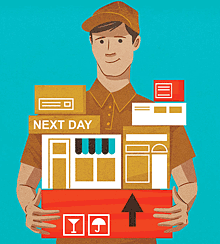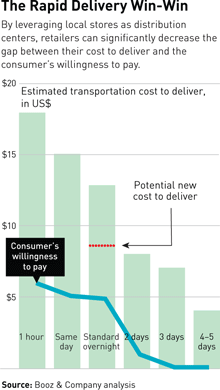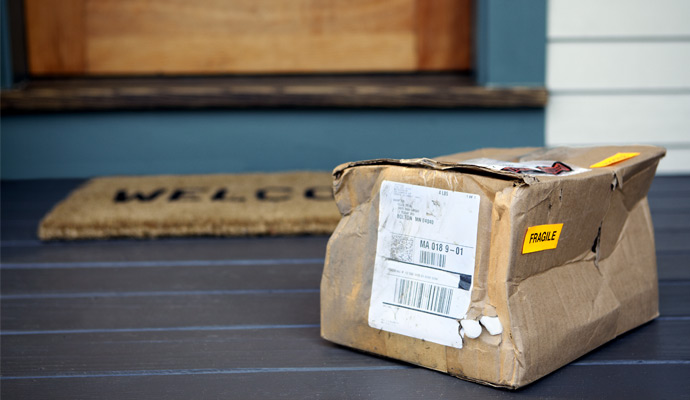Same-Day Delivery? Not So Fast
Traditional retailers can outshine their online competitors in the distribution game.
Note: This article was originally published by Booz & Company.
Offering customers free same-day delivery has long been an elusive goal for e-tailers. Their motivation is simple: If e-tailers can give customers the near-instant gratification of buying in a store, they can eliminate one of the most powerful advantages held by their bricks-and-mortar competitors. Alas, costs and complexity have largely kept same-day delivery (defined here as delivery between sunup and sundown on a weekday) out of reach and, at best, a niche offering.
There have been some notable recent developments, however. In July 2013, eBay unveiled an expansion of its eBay Now same-day delivery service into more areas around San Francisco and New York, with plans for Chicago and Dallas. On the heels of that announcement, Amazon said it would hire an additional 5,000 workers to staff its increasing number of U.S. fulfillment centers. Both are competing with Google Shopping Express, which launched a pilot service offering same-day delivery from a limited group of participating retailers to the San Francisco area in early 2013.
However, the demand for same-day delivery might be weaker than expected. According to a new Booz & Company survey of more than 1,000 online shoppers in the United States, most customers don’t necessarily need same-day delivery and, in fact, in many cases they don’t want it. They are getting home from work, going online, and placing an order. But they don’t want the item to arrive while they are making dinner or putting their kids to bed, let alone have it sit on their doorstep overnight.
This is where it gets interesting for traditional retailers that are willing to rethink their business model. By using their hundreds or thousands of physical storefronts as local distribution centers, bricks-and-mortar retailers are actually better positioned than e-tailers to deliver products rapidly to customers. And although our survey focused on the U.S., we believe the findings are applicable to other countries with well-developed retail and transportation sectors. With the possibility of free, ground-based, next-day delivery to consumers, the tables may be turning.
Paying and Waiting
To better understand online shopping habits and expectations, we asked consumers how much they would be willing to pay for delivery, and how long they would be willing to wait for their order to arrive. When it came to the first question, the answer was pretty blunt across the board: nothing or almost nothing. Nearly half of our survey respondents said they were unwilling to pay any fee whatsoever for delivery, and only about 10 percent said they would pay US$10 or more for same-day delivery. This finding confirmed earlier studies that have shown that customers’ online purchasing decisions often hinge on the issue of free shipping.
How long are customers willing to wait? Survey respondents indicated that overnight delivery was only 5 percent less valuable to them than same-day delivery, and three-quarters agreed or strongly agreed that they would be more likely to purchase goods from a retailer that offered free next-day delivery than from one that did not. The survey also revealed that 60 percent of online shoppers place most of their orders after traditional working hours (5 p.m. or later). Only 4 percent of shoppers make their purchases by 9 a.m., and only another 14 percent do so by noon.
Given these findings, the future may not bode well for several new, high-profile shipping offerings. They are either too expensive or too limited in their ability to accept orders after business hours—or both. For example, eBay Now’s service levies a $5 fee. AmazonFresh uses a subscription model, charging customers in Los Angeles $299 per year for “delivery by dinner” of orders placed by 10 a.m. Some traditional retailers are also throwing their hats in the ring. For a fee of $15 per order, Nordstrom will deliver goods to customers in La Jolla, Calif., Seattle, and Bellevue, Wash., by 7 p.m. if they are purchased by 1 p.m. that day. But these and other attempts at same-day delivery are likely to struggle to expand beyond their narrow geographies.
The Storefront Advantage
The trick for traditional retailers is to understand their positional advantage with regard to density (the number of packages being handled in a given geographic area). Free delivery depends on low delivery costs, and low delivery costs depend on density. This is because greater density in a single, planned dispatch minimizes the fuel, capital, and labor costs involved in a delivery. Traditional low-cost delivery models achieve density in two ways: long line-haul moves (typically by tractor-trailer) that allow companies to use large depots to aggregate supply, and overnight sorting at local delivery stations where incoming supply can gradually amass from multiple sources to fill delivery trucks. But both of these models tend to slow down delivery times.
E-tailers continue to wrestle with this density problem, but traditional retailers—particularly national and regional retailers—have a secret weapon that’s hiding in plain sight: their retail storefronts, which they can use as mini distribution centers and sources of fulfillment for local online demand (see Exhibit).
For example, a national retailer with several outlets in the Chicago area might receive hundreds of online orders from local customers after its warehouses are closed. But with the right systems in place, the company could identify which local retail stores that have those items in stock are still open. The company could then direct sales staff to select and package those items, and arrange for a local carrier to pick them up from the store before the doors close. The packages would go from the store to the local delivery station that evening, and the next morning be loaded onto trucks in time for the carrier’s normal local ground-delivery route. Even a smaller retailer without the necessary sales volume to justify a late-night, in-store carrier pickup could make the same overnight guarantee if, for instance, an employee dropped off the packages at a local delivery station on his or her way home from work.
A Rapid Delivery Strategy
Admittedly, this distribution strategy will not be easy for any retailer, and each needs to consider a range of questions: Which product categories are most sensitive to delivery speed? How do our customers’ needs change during the peak holiday season? Are time-definite delivery windows more valuable to our customers than overall speed?
Execution of this strategy, which would likely take several months to implement, will require retailers to take a cross-functional approach that involves thoughtful planning, IT investments, and close ties with transportation partners. Most important, it must treat stores and their inventory differently—not as a burden but as a source of competitive advantage. The following steps can help retailers get started.
Coordinate across channels. Senior leaders must commit to tearing down the last remnants of silos between offline and online domains. Full cooperation across traditional and digital offerings is required to make a nationwide plan for low-cost overnight delivery feasible and capable of reaching its full potential.
Enhance real-time inventory management. Inventory systems must provide transparency into where every SKU is located. This detail must go beyond knowing in which store an item can be found, to knowing in which department, down which aisle, and on which particular shelf.
Optimize fulfillment systems. Fulfillment systems are needed that can immediately determine which particular retail store can satisfy an order. This decision requires balancing factors such as proximity to the customer, current (and predicted) inventory levels, and staff capacity for selecting the ordered items and packing them for pickup.
Create a flexible workforce. Sales staff may be asked to fulfill online orders during what would otherwise be idle time. They need training to use the retailer’s order-taking technology and must learn how to locate, pack, and label items for shipment. New approaches to sales personnel compensation (especially at commission-heavy retailers) may also be required.
Develop robust logistics partnerships. It’s critical to select a transportation partner (or partners) capable of picking up parcels later in the evening than is currently typical, closer to store closing times of 9 to 10 p.m. Transportation partners might not enthusiastically offer late-night service, but the retail industry accounts for a substantial amount of their delivery business—which gives them a vested interest in helping traditional retailers compete with e-tailers.
Send a strong marketing message. A large-scale marketing campaign is important in helping retailers spread the word about a next-day delivery offering, and in articulating the benefits of ordering from the company’s website instead of from an e-commerce competitor.
Managing bricks-and-mortar stores has so consistently been framed as a disadvantage that it’s easy to underrate the value of physical proximity to customers. In reality, these stores may be just the advantage retailers need to gain an edge over their online competitors. A handful of retailers are already experimenting with the “store-to-home” concept, mostly to move out-of-season stock and leverage idle sales capacity—but not to fulfill orders in the evenings and get them to the customer’s door the next day. As Amazon, eBay, and Google push aggressively into rapid delivery, traditional retailers must not hesitate to respond. The storefront advantage is real, but it’s not permanent. ![]()
Reprint No. 00213
Author profiles:
- Curt Mueller is a partner with Booz & Company and leads the firm’s supply chain practice. He is based in Chicago.
- Andrew Schmahl is a principal with Booz & Company’s engineered products and services practice, and is based in Chicago.
- Andrew Tipping is a partner with Booz & Company and leads the firm’s U.S. transportation practice. He is based in Chicago.
- Also contributing to this article were Booz & Company partner Scott Corwin and principal Umut Aytekin.





